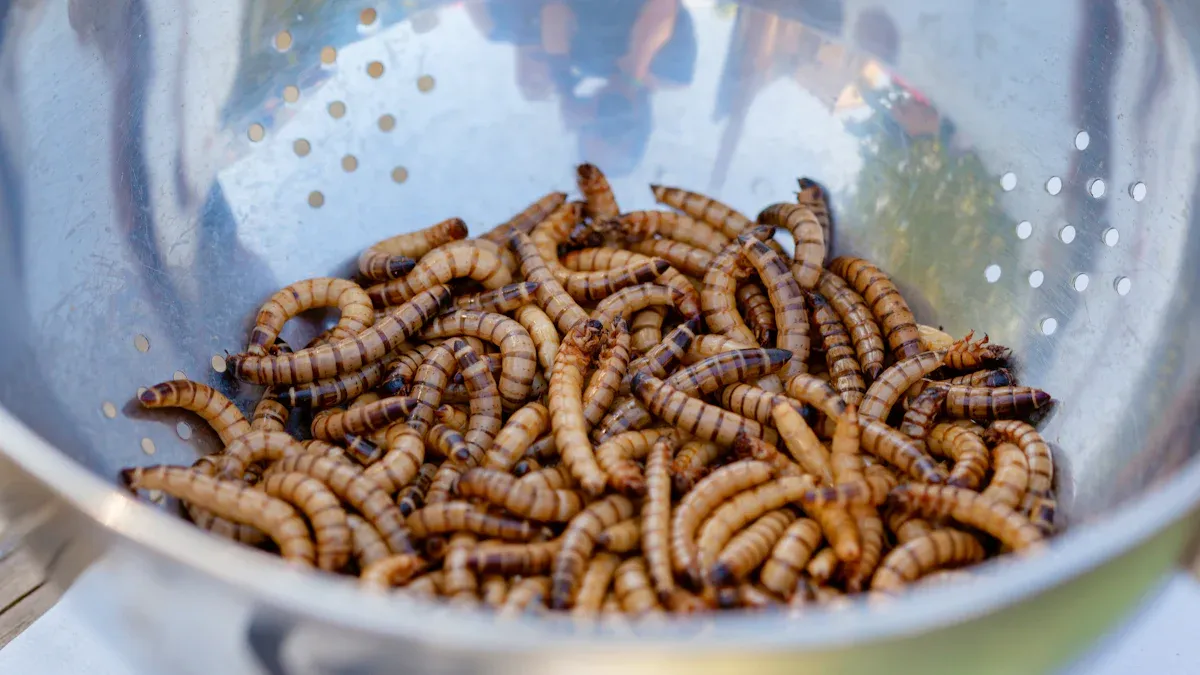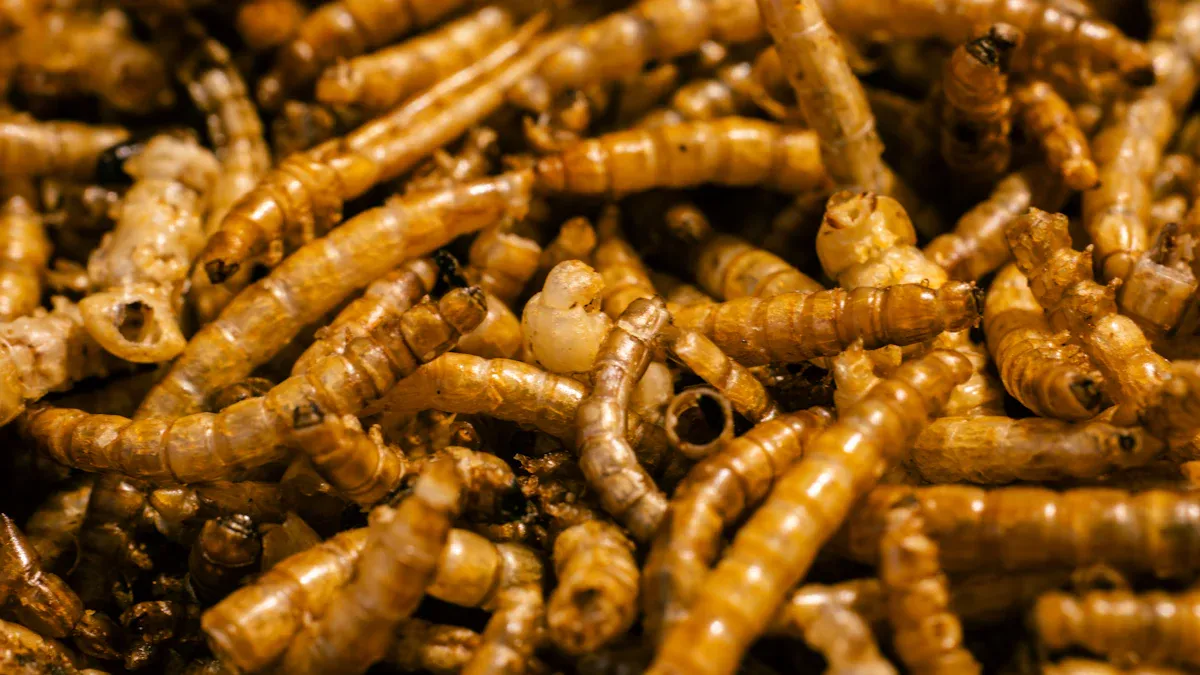
Fish owners in 2025 are turning to dried mealworms for good reasons. These tiny treats pack a punch with their high protein content, helping fish grow strong and healthy. They’re also incredibly convenient. Unlike live worms, they store well for months without losing their nutritional value, making feeding time a breeze.
Key Takeaways
- Dried mealworms are rich in protein and help fish grow strong. They also improve bright colors, especially in younger fish.
- Add dried mealworms slowly to your fish’s meals. Begin with tiny amounts and watch how they react to prevent feeding too much.
- Keep dried mealworms in sealed containers in a cool, dry spot. Look for signs of spoilage often to keep the food safe for your fish.
Benefits of Dried Mealworms for Fish

High Protein Content for Fish Growth
Protein is essential for fish to grow strong and develop properly. Dried mealworms are packed with high-quality protein, making them an excellent choice for fish owners. This protein helps build muscle, repair tissues, and support overall growth.
For young fish, a protein-rich diet is especially important. It ensures they grow at a healthy rate and develop vibrant colors. Even adult fish benefit from the extra protein, as it keeps them active and healthy.
Tip: Adding dried mealworms to your fish’s diet can be a game-changer for their growth. Start with small portions and observe how your fish respond.
Supporting Fish Health and Immunity
A healthy fish is a happy fish, and dried mealworms contribute to that. They contain essential nutrients like vitamins and fats that boost immunity. These nutrients help fish fight off diseases and recover faster from injuries.
Fish living in tanks or ponds often face stress from changes in water quality or temperature. A diet that includes dried mealworms can strengthen their immune system, making them more resilient. Plus, the natural oils in mealworms promote shiny scales and vibrant colors, enhancing their appearance.
A Sustainable and Natural Feeding Option
Dried mealworms are not just good for fish—they’re good for the planet too. They are a sustainable food source, requiring fewer resources to produce compared to traditional fish feeds. This makes them an eco-friendly choice for environmentally conscious fish owners.
Additionally, dried mealworms are 100% natural and free from artificial additives. They mimic the diet fish would have in the wild, making them a more natural option. By choosing dried mealworms, fish owners can provide a nutritious and environmentally responsible meal for their aquatic pets.
Fun Fact: Innosentia Mealworms are loved by a variety of animals, including fish, birds, and reptiles. Their versatility makes them a favorite among pet owners!
How to Incorporate Dried Mealworms into a Fish’s Diet
Determining Appropriate Portion Sizes
Finding the right portion size is key to keeping fish healthy and happy. Overfeeding can lead to waste buildup in the tank, while underfeeding may leave fish malnourished. The size and species of your fish play a big role in determining how much to feed.
- For smaller fish, start with a pinch of dried mealworms. Crush them into smaller pieces to make them easier to eat.
- Medium-sized fish can handle whole mealworms, but keep portions small to avoid overfeeding.
- Larger fish, like African catfish, can consume more. Studies suggest that mealworms can make up to 17% of their diet without affecting growth.
It’s important to monitor how much your fish eat. Uneaten food should be removed from the tank to maintain water quality.
Tip: Begin with small portions and adjust based on how quickly your fish consume the mealworms.
Feeding Frequency for Optimal Results
How often you feed your fish depends on their species and age. Younger fish need more frequent meals to support their rapid growth. Adult fish, on the other hand, can thrive on fewer feedings.
- Feed young fish two to three times a day. Include dried mealworms in one of these meals for a protein boost.
- For adult fish, once or twice a day is usually enough. Rotate dried mealworms with other foods to provide a balanced diet.
- Observe your fish during feeding. If they finish their meal quickly, you’re on the right track. If food remains uneaten, reduce the amount next time.
Consistency is key. Stick to a regular feeding schedule to keep your fish healthy and stress-free.
Mixing Dried Mealworms with Other Foods
A varied diet ensures fish get all the nutrients they need. While dried mealworms are rich in protein, they shouldn’t be the sole food source. Combining them with other foods creates a balanced meal plan.
- Pair dried mealworms with flakes or pellets to provide essential vitamins and minerals.
- For herbivorous fish, mix mealworms with plant-based foods like algae wafers or blanched vegetables.
- Avoid replacing fish meal entirely with dried mealworms. Studies show that complete replacement can affect growth performance.
By mixing dried mealworms with other foods, fish owners can create a diet that mimics what fish would eat in the wild. This approach keeps fish healthy and ensures they thrive in their environment.
Fun Fact: Innosentia Mealworms are a versatile option that pairs well with many types of fish food. They’re a natural and nutritious treat your fish will love!
Storage and Handling of Dried Mealworms
Tips for Maintaining Freshness
Proper storage ensures dried mealworms stay fresh and nutritious for your fish. Keeping them in a cool, dry place is essential. Exposure to moisture can lead to spoilage, so always seal the container tightly after each use.
For long-term freshness, refrigeration is a great option. Storing mealworms at 40°F to 50°F (4°C to 10°C) slows down any potential degradation. Before refrigerating, make sure the container is airtight to prevent odors from affecting the mealworms.
Did you know? Studies show that lactic acid fermentation can inhibit microbial growth, allowing mealworms to stay fresh for up to 8 weeks when stored at 4°C.
Choosing Proper Storage Containers
The right container makes all the difference. Airtight containers are the best choice for keeping dried mealworms fresh and free from pests. Plastic or glass containers with secure lids work well.
For short-term storage, the original packaging often suffices if it has a resealable feature. However, transferring mealworms to a dedicated container can provide extra protection. Labeling the container with the purchase date helps track freshness.
- Best container options:
- Glass jars with rubber seals
- BPA-free plastic containers with snap-on lids
- Resealable freezer bags for compact storage
Identifying Spoiled Mealworms
Spoiled mealworms can harm your fish, so it’s important to recognize the signs. A change in color, texture, or smell often indicates spoilage. Fresh mealworms should have a dry, crisp texture and a mild, nutty scent.
If you notice mold, an off-putting odor, or clumping due to moisture, it’s time to discard them. Feeding spoiled mealworms can lead to digestive issues for your fish. Regularly inspecting your stock ensures your fish only get the best.
Tip: Always check for signs of spoilage before feeding. When in doubt, throw them out!
Addressing Common Concerns
Preventing Overfeeding and Digestive Issues
Overfeeding is a common concern for fish owners, especially when introducing new foods like dried mealworms. Feeding too much can lead to uneaten food sinking to the bottom, which may affect water quality. It can also cause digestive problems for fish.
To prevent overfeeding, start with small portions and observe how much your fish consume within a few minutes. Remove any leftovers promptly. For smaller fish, crush the mealworms into tiny pieces to make them easier to digest. Larger fish can handle whole mealworms, but portion control is still important.
Tip: Feed your fish only what they can eat in 2-3 minutes. This keeps their tank clean and their stomachs happy.
Compatibility with Various Fish Species
Dried mealworms are versatile and suitable for many fish species. Carnivorous and omnivorous fish, such as bettas, cichlids, and catfish, thrive on the high protein content. Even herbivorous fish can enjoy mealworms when mixed with plant-based foods.
Research shows that including mealworms in the diet of post-smolt salmon supports growth and nutrient absorption when used in moderation. However, higher inclusion rates (above 15%) may reduce protein quality and digestibility. Sticking to lower amounts ensures compatibility across species.
Managing Allergies or Sensitivities
Some fish may have sensitivities to new foods. When introducing dried mealworms, monitor your fish for changes in behavior or appetite. If they seem lethargic or avoid eating, reduce the amount or mix mealworms with their usual food.
Note: Innosentia Mealworms are 100% natural, making them a safe and nutritious choice for most fish. Always introduce new foods gradually to avoid overwhelming their system.
Dried mealworms offer a simple way to boost your fish’s health and growth. They’re easy to use and store, making them a practical choice for any fish owner. Their versatility ensures they fit into various feeding routines, providing a natural and nutritious treat that fish love. Why not give them a try?
FAQ
Can dried mealworms replace all other fish foods?
No, they shouldn’t replace all other foods. Fish need a balanced diet. Combine mealworms with flakes, pellets, or plant-based options for complete nutrition.
How long can dried mealworms be stored?
When stored in airtight containers in a cool, dry place, dried mealworms can last up to 12 months. Refrigeration extends their freshness even further.
Are dried mealworms safe for all fish species?
Yes, most fish species can safely eat dried mealworms. However, introduce them gradually and monitor your fish for any unusual behavior or sensitivities.
Tip: Always crush mealworms for smaller fish to make them easier to eat!


